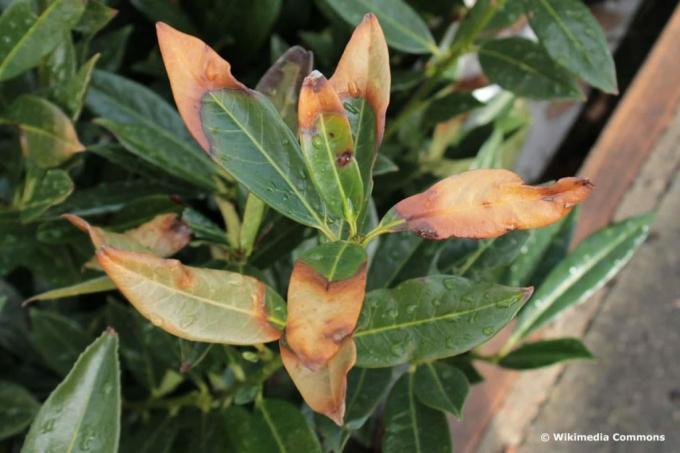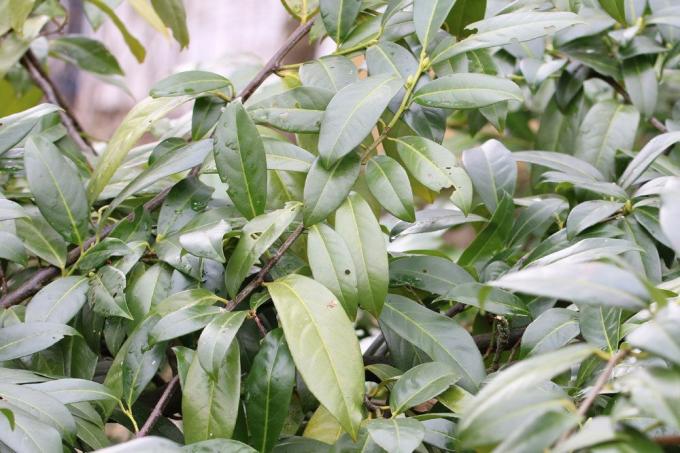
table of contents
- Frozen or dried up?
- Frost drought - most common frost damage
- Frostbite damage
- Measures against frost damage
- Prevent frost damage
- Sufficient winter protection
- Proper fertilization
- Suitable location
- Optimal irrigation
- frequently asked Questions
Frost damage to the evergreen cherry laurel is not uncommon. Of course, the winter hardiness of the respective variety also plays a decisive role. The damage can be particularly pronounced in extremely cold winters.
In a nutshell
- Frost damage does not necessarily mean frostbite
- in most cases it is more likely to be damage caused by drought
- Frostbite can only be traced back to freezing temperatures
- Drought damage, so-called frost drought, occurs due to a lack of water
- large-leaved varieties are particularly often affected
Frozen or dried up?
It is not easy for laypeople to use the damage pattern to recognize whether it is frost dryness or frostbite. Both express themselves in brown leaves and leaf loss. Even whole shoots can die. Most species are usually well hardy. However, there are some less robust ones that can freeze to death in exceptionally freezing temperatures. In most cases, frost damage is damage caused by drought, the cherry laurel or cherry laurel. Parts of the plant have dried up.
Frost drought - most common frost damage
Basically, the plants protect themselves from the cold and dehydration by rolling up the leaves. It becomes problematic with a combination of intense winter sun, cold, wind, dry air and a deeply frozen ground over a longer period of time. These factors reinforce each other, the cherry laurel evaporates more water through its large leaves due to the sun. Because the ground is frozen at the same time, the plant can no longer absorb water, it dries up, especially the green parts of the plant. Leaves and shoots turn brown.

Frostbite damage
Species that are more sensitive to frost, such as Prunus laurocerasus 'Rotundifolia', are particularly susceptible to frostbite. It can freeze back a lot in icy temperatures. If you live in a region where it can get particularly frosty in winter, you should opt for varieties with good winter hardiness.
- Specimens with normal winter hardiness do not freeze back completely
- Damage can only be seen on shoots above the snow cover
- Snow cover forms a very good insulation
- all parts under the snow cover are adequately protected
- if there is no snow, frostbite can also go deeper
- young shoots are particularly at risk
- The lowest parts, including the roots, usually survive winter without major damage
Tip: The varieties Prunus laurocerasus 'Ethna', 'Herbergii', 'Diana', 'Mount Vernon', 'Otto Luyken' and the Portuguese cherry laurel (Angustifolia), for example, have good winter hardiness.
Measures against frost damage
Once winter is over, the full extent of the damage can be seen. Usually it looks more dramatic than it actually is. The stems are usually still green and will soon sprout again. Now you should definitely not start cutting straight away, but first be patient and wait. If you cut too early, there is a risk of late frosts, which can damage the new shoot.
- Remove frost damage only after the ice saints
- new shoots and leaves can usually already be seen
- Cut out dried or frozen shoots and leaves
- Cut damaged branches into healthy wood
- Completely remove any dry branches inside
- Cutting back by 10-15 cm is usually sufficient
- if budding occurs further down, trim again if necessary
- in the case of extensive damage, shorten to 20 cm (put on the stick)
- Remove clippings
- ensure constant soil moisture in the following months
- Apply the first fertilization with the new shoot

Prevent frost damage
In order to prevent frost damage to cherry laurel of any kind, it is easiest to pay attention to particularly frost-hardy varieties when replanting. This already gives you a very good basis. But even with existing plantings there is a lot that can be done to counteract such damage.
Sufficient winter protection
- in the form of a layer of mulch
- Spread about ten centimeters thick on the root area
- also protect the parts above ground
- with vertical fir branches, fleece or shading net
- Fleece can prevent excessive evaporation
- Specimens in the bucket require more protection
- Place in a sheltered place
- on wooden pallet or styrofoam plate
- Wrap the bucket with burlap, fleece or bubble wrap
- Cover the root area with mulch
- from bark mulch or dry leaves
- The bucket should be made of frost-resistant material
Foil to protect the above-ground parts of the plant is completely unsuitable. It offers no shade and the leaves underneath would be very warm from the winter sun. In addition, no air exchange is possible, which promotes fungal infections.
Proper fertilization
The right fertilization at the right time can have a positive effect on the winter hardiness of the cherry laurel and prevent frost damage. The last time you fertilize in May / June with a potash fertilizer (patent potash). This ensures that the plants are sufficiently lignified by winter and that the leaves also become more resistant to frost.
In any case, nitrogen-based fertilization in late summer should be avoided. It would encourage late budding. However, the young shoots can no longer harden until the first frost. The result would be considerable frost damage.
Suitable location
A well-chosen location can also provide good frost protection. This evergreen wood cannot stand full sun. It feels most comfortable in protected locations in partial shade or shade and should be protected from direct sun in the morning and noon as well as from sharp easterly winds.

Optimal irrigation
Proper watering is particularly important in winter. In autumn it is advisable to water the plants sufficiently. In winter, on frost-free days or be poured when the bottom is open to avoid frost drought. After prolonged periods of frost when water cannot be watered, it is important to irrigate as soon as the temperature starts to rise. This gives the plants the opportunity to rebalance their water balance.
frequently asked Questions
How quickly cherry laurel recovers depends on the frost damage. If only the fresh runners are affected, it usually recovers within a few weeks. If most of the leaves are frozen to death but the vascular bundles under the bark are still intact, it can take a few months. Here the plant just needs to form new leaves and buds. You can test whether the laurel is still green and juicy under the bark by removing some of the bark.
The annual increase depends on the variety and the site conditions. As a rule, all varieties are relatively fast-growing. The particularly fast ones can gain up to half a meter per year.
Specimens in the bucket can of course also overwinter inside, which is particularly useful in regions with very cold winters. The winter quarters should be bright and unheated with temperatures between three and ten degrees.
All parts of this plant are poisonous, especially leaves, fruits and seeds. The small black berry-like fruits are formed after flowering. They are definitely a danger to young children.



